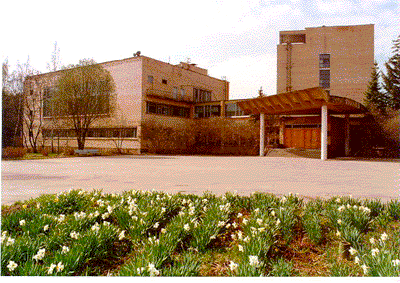

|
The Institute for High Pressure Physics, Russian Academy of Sciences (IFVD RAN) is a unique scientific organization, and its activities are entirely devoted to the study of fundamental and applied physics of intensely compressed substances. |
|
The Institute, founded by Academician L.F. Vereshchagin in 1958, received international recognition in the beginning of 1960's due to the successful synthesis of diamond and cubic boron nitride. The original equipment and technologies, developed in the Institute, were introduced to more than 45 organizations and established the basis of the diamond industry in the USSR. The subsequent synthesis of a superdense silica modification, that won world-wide recognition and led the path for future investigations of the physics of the Earth and planets, confirmed the position of the Institute as a first-class scientific organization. At the same time, a high pressure physics discipline was also developed at the Institute that included investigations of structural, elastic, and electronic properties of the solid under high pressures and resulted in many considerable scientific achievements. The Institute has received 2 certificates of discoveries (the synthesis of dense silica phase and detection of electronic topological transition under high pressure), about 400 patents of inventions (of these 48 abroad) and published more than 3500 papers. At present, the Institute has 12 scientific and applied scientific subdivisions with 115 research workers, (20 Doctors of Science and 76 Candidates of Science). The scientific mission of the Institute concerns the investigation of substance properties in conditions of strong static compression that can be divided in two basic parts: Fundamental investigations of the structure, electronic properties, stability and phase transformations under pressure in various substances, including the construction of theoretical models of observed phenomena. High pressure materials technology, which includes syntheses of new materials and investigation of their properties. This direction covers the synthesis of diamond and cubic boron nirtide monocrystals, as well as new crystalline and amorphous forms of carbon; the development and investigation of new composite ultradispersed superhard materials and alloys; as well as the development of technology for producing various types of tools on the basis of superhard materials. The Institute has a wide range of contacts with scientific organizations in Russia and abroad. Joint investigations are held with institutes of the Russian Academy of Sciences such as: the Institute of Crystallography, the Physical Institute, the Institute of General Physics, as well as the Joint Institute for Nuclear Researches, the Institute of Graphite, the Moscow State University, Los Alamos National Laboratory (USA), Geophysical Laboratory of Carnegie Institute (Washington, USA), Oxford and De Montfort Universities (UK), Grenoble High Magnetic Field Laboratory (France), the International Laboratory of High Magnetic Fields (Poland), and a number of other scientific organizations from Germany, Poland, France, USA, China, Japan. Technological developments and scientific equipment made in the Institute are applied in many scientific centers and companies of Great Britain, Germany, France, USA, China, and other countries. Because efficient and up-to-date scientific work in the field of high pressure physics cannot be carried out in the framework of a single institute, no matter how large it may be, without using powerful sources of neutron and synchrotron radiations, highly efficient computers, etc, the institute continues to promote international scientific collaboration and is always ready to cooperate in the field of fundamental and applied investigations. |

|
~
About HPPI ~
Scientific divisions ~
Scientific activities ~
Our products ~
~ Office of the director ~ |